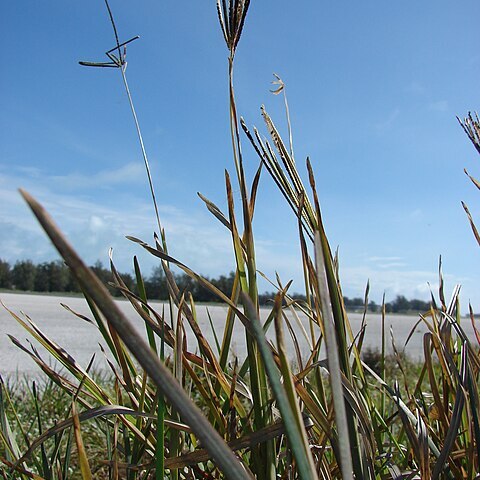Annuals or perennials. Leaf sheaths strongly keeled; leaf blades linear, flat or folded, apex often obtuse; ligule a ciliate rim. Inflorescence digitate; racemes unilateral, slender; spikelets sessile, tightly pectinate-imbricate, biseriate. Spikelets laterally compressed, florets 2, lower floret fertile, upper floret reduced to a small empty lemma, disarticulating above glumes; glumes about as long as florets, broad, membranous, 1-veined; lower glume awnless; upper glume with an oblique, stout, subapical awn; callus pubescent; lemma of fertile floret dark brown, keeled, broad, cartilaginous to leathery, 3-veined, hairy on veins, apex acute to emarginate, awnless or with a fine, subapical awn-point; palea nearly as long as lemma, keels scabrous or ciliolate; upper floret cuneate or obovate, glabrous. Caryopsis ellipsoid, trigonous, pericarp reluctantly free.
Annuals or perennials, caespitose, bisexual. Ligule a fringe of hairs. Inflorescence a single spike, or digitate, usually with more than 15 pectinate spikes, sometimes also bearing sterile spikelets, with spikelets secundly arranged. Bisexual spikelets biseriate, not noticeably to laterally compressed, with 1 bisexual floret, disarticulating above the glumes; rachilla prolonged beyond the bisexual floret with incomplete florets; glumes 2, very unequal to almost equal; lower glume shorter, carinate, 1-nerved; upper glume ±equalling spikelet, with a small awn or awned subapically, 1-nerved; callus minute, pubescent or bearded; basal lemma acute to emarginate, entire or notched, barely awned to shortly awned, decidedly firmer than glumes, firmly membranous to leathery, carinate, 3-nerved, hairy on margins and keel. Caryopsis trigonous; hilum short.
Spikelets 2(3)-flowered, sessile, alternate in 2 rows on a tough axis, disarticulating above the glumes; glumes unequal, membranous, lanceolate to oblong in profile, shorter than the spikelet, 1-nerved, the superior longer and broader than the inferior and with a short straight awn from just below the apex; lowermost floret fertile; fertile lemma elliptic in profile, dark or golden-brown, cartilaginous to chartaceous, laterally compressed and keeled, acute to emarginate, with or without a short awn from just below the membranous apex; uppermost floret reduced to a small clavate lemma (sometimes with a minute palea) crowning the rhachilla; rarely an intermediate male floret present.
Inflorescence of 2–many digitate 1-sided racemes bearing densely packed spikelets.
Caryopsis obovoid, plump.

